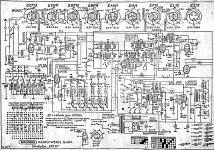Last weekend an old fried of mine gave to me a Grundig 475W radio that once had belonged to his grandma. The apparatus has been made in about 1950/51 and is somewhat outstanding, as it features a front end for the then-new FM, two AM, three SW and one LW band(s), several switchable sounds, three speakers and a rather powerful amplifier. Besides the Loctal tuning indicator, all valves are of the German Octal type, the small signal ones being original Telefunken steel tubes, while the rectifier and the power valve feature glass envelopes. The radio works basically, with a really beautiful sound coming out of the two woofers and the tweeter. Surely it has been quite an expensive purchase in those days
Unfortunately, grandma used to put flower vases on top of it. So the varnish has become heavily damaged here. I see several water rings and find laquer missing at a small spot, whereas the wooden veneer seems to be healthy. No question, I've decided to bring this radio back to it's former beauty. How would you recommend me to do it? I think I'll have to sand down the top side laquer at least and spray new laquer onto it. Do you see some other options? Do I even have to sand, spray and polish the complete enclosure? Which spray laquer do I need?
Best regards!
Unfortunately, grandma used to put flower vases on top of it. So the varnish has become heavily damaged here. I see several water rings and find laquer missing at a small spot, whereas the wooden veneer seems to be healthy. No question, I've decided to bring this radio back to it's former beauty. How would you recommend me to do it? I think I'll have to sand down the top side laquer at least and spray new laquer onto it. Do you see some other options? Do I even have to sand, spray and polish the complete enclosure? Which spray laquer do I need?
Best regards!
Last edited:
It was not lacquer but shellac based varnish around that era.
https://en.wikipedia.org/wiki/French_polish
I would turn to an expert art restorer - depending on your budget.
(You can also place a flower vase on top of it - it was the way those masterpieces were used 😉)
https://en.wikipedia.org/wiki/French_polish
I would turn to an expert art restorer - depending on your budget.
(You can also place a flower vase on top of it - it was the way those masterpieces were used 😉)
Thank you! So at first I'll have to find out of which kind the lacquer is. I may remove a little piece of varnish from the yet damaged spot and try to solve it in ethylic alcohol. If it solves, then most probably it is shellac - and I'll indeed have to consult a professional.
Btw, do you know this apparatus? There are many beautiful pictures at Antique Radios, 285 256 Antique Radios listed. Later this day I might post some photographs of mine here.
Best regards!
Btw, do you know this apparatus? There are many beautiful pictures at Antique Radios, 285 256 Antique Radios listed. Later this day I might post some photographs of mine here.
Best regards!
Last edited:
I just did an old Blaupunkt. The shellac was badly damaged. After removing all plastic parts I gently, with a heatgun or hairdryer softened the shellac. Starting at a damaged area, gently peeled the finish off, using a dull, clean-edged scraper. Once I got started and used to the work (my first attempt at such a job) it went quite quickly.
Beneath the shellac was a beautiful walnut veneer. After sanding it with an orbital rotary sander (400 grid paper) I only used Danish oil to protect the veneer. Beautiful!
Good luck! E
Beneath the shellac was a beautiful walnut veneer. After sanding it with an orbital rotary sander (400 grid paper) I only used Danish oil to protect the veneer. Beautiful!
Good luck! E
Thank you for your advice!
I prefer to recrete it's original high gloss finish, though, so this sadly isn't an option for me.
Here are some photos of my Grundig:
Best regards!
I prefer to recrete it's original high gloss finish, though, so this sadly isn't an option for me.
Here are some photos of my Grundig:
Best regards!
Attachments
-
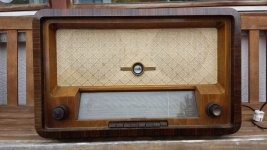 20170702_124634.jpg174.3 KB · Views: 135
20170702_124634.jpg174.3 KB · Views: 135 -
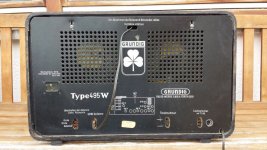 20170702_124719.jpg175.6 KB · Views: 143
20170702_124719.jpg175.6 KB · Views: 143 -
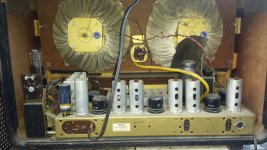 20170704_204839.jpg167.8 KB · Views: 143
20170704_204839.jpg167.8 KB · Views: 143 -
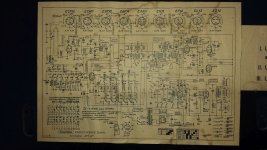 20170704_205044.jpg207.7 KB · Views: 89
20170704_205044.jpg207.7 KB · Views: 89 -
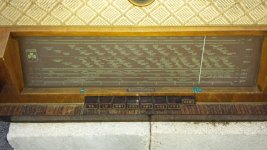 20170704_205223.jpg989.8 KB · Views: 87
20170704_205223.jpg989.8 KB · Views: 87 -
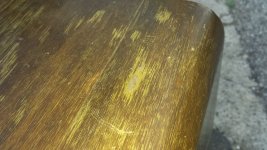 20170704_204709.jpg184.8 KB · Views: 97
20170704_204709.jpg184.8 KB · Views: 97 -
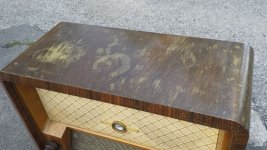 20170704_204639.jpg186.9 KB · Views: 100
20170704_204639.jpg186.9 KB · Views: 100 -
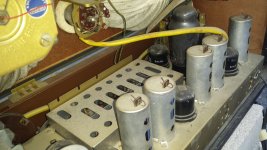 20170704_204946.jpg167.3 KB · Views: 137
20170704_204946.jpg167.3 KB · Views: 137 -
 20170704_204926.jpg183 KB · Views: 137
20170704_204926.jpg183 KB · Views: 137
Last edited:
There are many organisations of people who restore old radios or other old electronic equipment, maybe one of their websites can help you. Try GFGF e.V. or Antique WirelessAssociation - Home or BVWS - British Vintage Wireless Society
If you can read Dutch (with or without a little help of Google translate), there is a very useful tips and tricks section on Nederlands Forum over Oude Radio's
If you can read Dutch (with or without a little help of Google translate), there is a very useful tips and tricks section on Nederlands Forum over Oude Radio's
Pass DIY Addict
Joined 2000
Paid Member
You have a beautiful radio there! I would recommend lots of reading about how to restore an old wooden radio cabinet before you do anything to this! Please don't just start with sand paper, it may not be necessary.
A little while ago, I completely refinished an old RCA Radiola 17 (from 1924) and documented the entire process here.
Here is a GREAT thread that will provide some additional detail about how to refinish wooden cabinets: Antique Radio Forums • View topic - Philco 90 cabinet questions
A little while ago, I completely refinished an old RCA Radiola 17 (from 1924) and documented the entire process here.
Here is a GREAT thread that will provide some additional detail about how to refinish wooden cabinets: Antique Radio Forums • View topic - Philco 90 cabinet questions
Thank you 🙂! Yes, I like it very much, too, and in addition it may have some value, as it has been quite a expensive device in about 1950.
Before doing anything to it's enclosure, I'm going to read a lot and exercise with other radios of less value that I also own.
Best regards!
Before doing anything to it's enclosure, I'm going to read a lot and exercise with other radios of less value that I also own.
Best regards!
I met someone, by chance, a while back who restored furniture for "english heritage" - which is a charity here that owns several historic buildings of interest (etc)
Someone like that would certainly have the skill set for a vintage piece such as yours.
I obviously have no idea as to costings or anything like that, but i suspect it is one of the many areas where skill does not necessarily translate directly to wage!
Someone like that would certainly have the skill set for a vintage piece such as yours.
I obviously have no idea as to costings or anything like that, but i suspect it is one of the many areas where skill does not necessarily translate directly to wage!
Nice radio 🙂
EL12 SE amp stage, ~8w
I cleaned up the schema a bit (for others, you have the original 🙂). Looks like they have the fairly common (in the day) single ended electrostatic tweeter with direct drive.
dave
EL12 SE amp stage, ~8w
An externally hosted image should be here but it was not working when we last tested it.
I cleaned up the schema a bit (for others, you have the original 🙂). Looks like they have the fairly common (in the day) single ended electrostatic tweeter with direct drive.
dave
Attachments
Yes, thank you! At first glance, you don't find the tweeter. It's a coaxial one, housed in the right speaker (as seen from the front).
Best regards!
Best regards!
- Status
- Not open for further replies.
- Home
- Design & Build
- Construction Tips
- Repairing a radio enclosure
